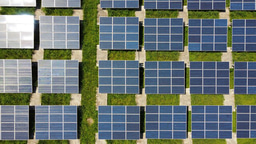Advancing Efficient Decarbonization: Trade-offs and synergies among carbon mitigation policies
Published in Social Sciences and Earth & Environment
Global warming poses a major challenge to the sustainable development of national economies and societies, making the reduction of greenhouse gas emissions a critical international environmental issue. As the largest CO2 emitter and the second-largest economy in the world, the achievement of China’s carbon neutrality is crucial for the 1.5°C target of the Paris Agreement.
Why Focus on Policy Interactions in Emission Reduction?
China has proposed a range of mitigation policies to meet its dual carbon targets, including developing non-fossil energy, increasing the electrification rate, enhancing energy efficiency, and implementing market-based measures such as carbon pricing. However, real-world implementation is far more complex. The interactions among these policies can lead to unexpected trade-offs or synergies, influencing not only their overall mitigation effectiveness but also the economic costs and timeline for achieving carbon neutrality.
Our research focus on this critical aspect: the interaction mechanisms between emission reduction policies. Rather than simply sum up the anticipated benefits of individual policies, we evaluate how combining and sequencing policies can weaken or strengthen their effects. As existing research has shown, there is a nonlinear interplay among various policies, simply aggregating the (seemingly ideal) effects of multiple policies does not accurately reflect the actual policy outcome. Combining and sequencing policy implementation can largely impact the efficiency, stringency, and externality of mitigation policies. This intricate interplay among policies will have a significant impact on both policy effectiveness and the broader energy transition.
The Story Behind the Batch Scenario Simulations
To address this problem, we create a comprehensive policy portfolio area toward 2060, consisting of 1,295 scenarios covering four major mitigation strategies. Meanwhile, we develop a dynamic computable general equilibrium model of China (CEEGE model), which can depict the cost-neutrality mechanisms of mitigation policies, capture dynamic sectoral changes through the upstream-downstream industrial chain, and adjust both quantity and price at equilibrium simultaneously. Furthermore, we design three indicators to measure the trade-offs and synergies between policy portfolios in terms of carbon-mitigating effects, economic costs of mitigation, and carbon-mitigating efficiency.
In our research, we faced two main challenges. The first challenge was how to capture the potential evolution of various mitigation policies and technologies over the next 40 years. On one hand, the development of key energy technologies, including improvements in sectoral energy efficiency, advancements in CCS and energy storage technology, is highly uncertain. The development of various technologies will significantly influence the future energy structure and determine the extent of achievable emission reductions. On the other hand, it is uncertain for the stringency of future government mitigation policies. This also means the implementation intensity of measures such as carbon pricing remains unknown, and different strengths of mitigation policies may lead to a nonlinear changing trend or turning point for reduced emissions and economic losses.
To address these potential uncertainties, we conducted a comprehensive review of over 3,500 relevant studies and national policies published since the announcement of the carbon neutrality target. This review allowed us to systematically assess the potential development trajectories of various energy technologies. Based on these assessments, we established multiple development scenarios for each technology to capture a broad range of potential future advancements in emission reduction technologies and policies. Additionally, we incorporated the dynamic development of CCS and energy storage technologies within the model using cost curves, enabling an endogenous representation of their evolution and a more precise evaluation of their impact on the energy transition.
Besides, when evaluating policy interactions, we must thoroughly account for the interplay among different types of emission reduction policies at varying intensity levels. This comprehensive assessment requires running thousands of simulations. As a result, a single run demands substantial time, memory, and computational resources, leading to a low fault tolerance and making experiment replication challenging. To address this issue, we migrated our simulations from standard computing platforms to a supercomputing facility. Leveraging the immense computational power and parallel processing capabilities of supercomputers, we are able to significantly accelerate the simulation process and reduce computational complexity.
The Main Findings
We find that interactions between mitigation policies in China would reduce the percentage of scenarios achieving carbon neutrality by 2060 by 84%, and delay the years in which these scenarios are achieved by five to six years (Figure 1). Under the assumption of no policy interactions (ISSA), the proportion of scenarios achieving carbon neutrality by 2060 is 23.5%, with an average achievement year of 2054. However, when policy interactions are considered (ASIA), the proportion decreases to 3.7%, and the average year of achieving carbon neutrality is delayed to 2059.
Figure 1 Emission pathways in China from 2020 to 2060
Further quantitative analysis reveals that among all mitigation policies, the combination of renewable energy and electrification policies (R&E) exhibits dual synergy effects, contributing to both mitigating economic losses and achieving emission reduction targets (Figure 2). Specifically, electrification policies drive the transition of end-use sectors toward electrified consumption patterns by expanding electricity demand, while renewable energy policies continuously promote the development of low-cost renewable power, optimizing the power generation mix. The joint implementation of these two policies generates a stronger synergistic effect compared to their individual implementation.
In contrast, the policy combination of carbon pricing and renewable energy policies (C&R) demonstrates a trade-off effect in terms of both emission reduction and economic impact. Carbon pricing policies drive energy system transformation by increasing the cost of fossil fuel use, whereas renewable energy policies enhance the competitiveness of clean energy by reducing its cost. Given the overlapping impact mechanisms between these two policies, the combined implementation significantly weakens their overall effectiveness.

Figure 2 Carbon reduction and economic cost of policy combinations considering policy interactions
This study reveals the trade-offs and synergies among China’s carbon neutrality policies. It highlights the critical role of optimizing policy combinations and implementation sequences in advancing China’s decarbonization process, and provides valuable insights for China and other developing countries undergoing energy transitions.
More details of this study can be found in our recent article “Mitigation policies interactions delay the achievement of carbon neutrality in China” published in Nature Climate Change.
Liu, Y., Du, M., Yang, L. et al. Mitigation policies interactions delay the achievement of carbon neutrality in China. Nat. Clim. Chang. 15, 147–152 (2025).
DOI:https://www.nature.com/articles/s41558-024-02237-2
Follow the Topic
-
Nature Climate Change

A monthly journal dedicated to publishing the most significant and cutting-edge research on the nature, underlying causes or impacts of global climate change and its implications for the economy, policy and the world at large.



Please sign in or register for FREE
If you are a registered user on Research Communities by Springer Nature, please sign in